Table of Contents
Table of Contents
Whether you're a business owner or an IT pro, you know that a solid network is the foundation of your organization’s success. And that’s where Network Reliability comes in.
Think about it: a key video call with a client, a crucial file transfer right before a deadline, or an online transaction on your e-commerce site. What do they all have in common? They all depend on a network that just works—no glitches, no interruptions.
This blog is your go-to guide for understanding network reliability. We’ll dive into the essentials of measuring, testing, and, most importantly, improving the reliability of your network. In today’s digital world, downtime means missed opportunities and lost revenue, so getting a grip on your network’s reliability is more important than ever.
Learn how to check your network’s health, test it out, and make real improvements that’ll lead your business to unbeatable digital resilience. Let’s dive into the world of network reliability!
Let’s start with a definition to ensure that we’re all on the same page.
Network reliability refers to the ability of a computer network or telecommunications system to consistently and predictably perform its functions without experiencing failures or interruptions. In simpler terms, network reliability refers to how consistently and dependably a network performs without interruptions or failures.
It's all about ensuring that your network can deliver data, services, and applications seamlessly over time, with minimal downtime or issues. A reliable network means it’s able to handle the traffic it’s designed for, perform under pressure, and recover quickly when problems do arise.
There are many key factors that contribute to network reliability, such as:
- Uptime: How often the network is available and functioning properly.
- Consistency: How stable the network's performance is, with minimal fluctuations in speed, latency, or packet loss.
- Fault Tolerance: The network’s ability to continue functioning even when parts of it fail or experience issues.
- Resilience: The network’s capacity to quickly recover from failures or disruptions, minimizing downtime.
- Scalability: The ability of the network to grow or adjust without sacrificing performance or reliability.

In short, a reliable network ensures that users can access what they need, when they need it, without constant disruptions.
In the realm of network management, the path to improving reliability begins with precise measurement. Measuring network reliability is like checking the health of your network, you want to make sure it’s running smoothly and ready to bounce back if anything goes wrong. By keeping an eye on things like uptime, latency, and packet loss, you can catch issues before they cause chaos.
Measuring network reliability involves measuring various aspects of network performance and network stability. More simply put, you need to evaluate different factors that contribute to the network's consistent performance and its ability to recover from disruptions.
1. Network Availability:
Availability is one of the fundamental metrics for network reliability. It refers to how often the network is actually up and accessible to users, and it’s typically expressed as a percentage. High availability signifies better reliability.
Network availability is often calculated using the formula: (Uptime / (Uptime + Downtime)) x 100. You calculate it by dividing the total uptime by the total time (including downtime) over a specific period. For example, 99.9% availability means the network was down for about 8.76 hours in a year.
2. Network Uptime
This is the big one! Network Uptime is all about how much time your network is up and running without issues. A reliable network should have as little downtime as possible. The more uptime, the better!
3. Packet Loss:
Packet loss occurs when data packets fail to reach their destination. High packet loss rates can degrade network performance and reliability, impacting applications and services. Even small amounts of packet loss can cause slowdowns or glitches, especially with apps like VoIP or video conferencing.
3. Latency:
Network latency measures the time it takes for data packets to travel from the source to the destination. Think of latency like the delay before your network responds to a request.
Low latency is essential for real-time applications like voice and video communication, and VoIP (VoIP latency).High latency means longer waiting times.
4. Jitter:
Jitter refers to the variation in packet arrival times. Consistent jitter is crucial for maintaining the quality of voice and video calls as avoiding issues like VoIP jitter. A reliable network keeps jitter as steady as possible.
5. Throughput:
Throughput measures the amount of data that can be transmitted over the network in a given time. If you have a lot of users or devices, you’ll need a network that can keep up without slowing down.
6. Error Rates:
Error Rate measures how often data is corrupted or lost during transmission. High error rates mean a less reliable network, as data needs to be retransmitted, causing delays.
7.Recovery Time:
If something goes wrong, how quickly does your network bounce back? Faster recovery time means better reliability overall.
8. Mean Time Between Failures (MTBF):
MTBF quantifies the average time between network failures. A higher MTBF indicates better reliability. It helps in predicting when the next failure might occur, enabling proactive maintenance.
9. Mean Time to Repair (MTTR):
MTTR measures the average time it takes to repair a network failure once it has occurred. Lower MTTR values indicate quicker recovery and better network reliability.
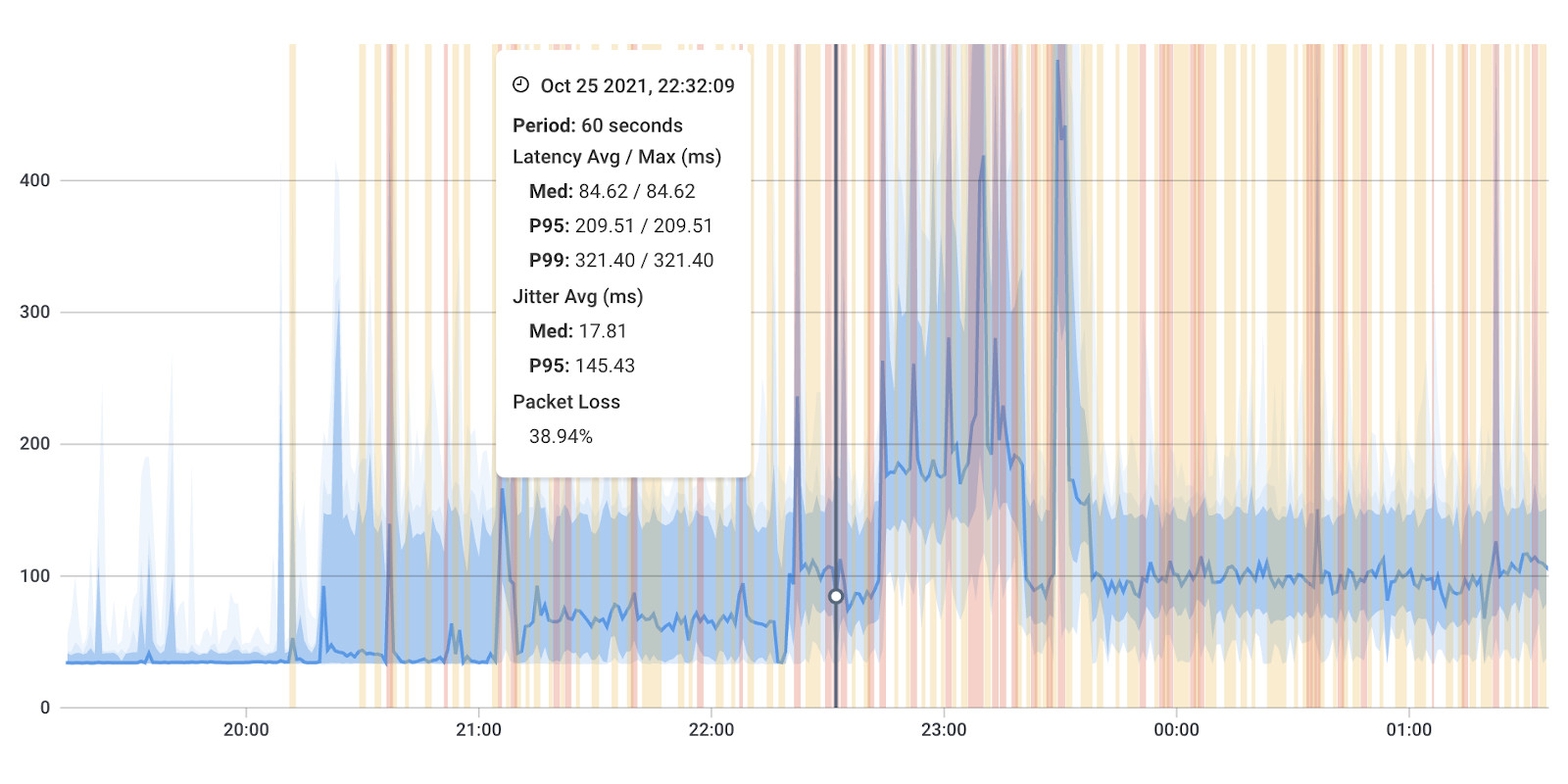
Measuring, testing, and enhancing network reliability has never been easier. With Obkio's Network Performance Monitoring tool, you can take control of your network's performance and ensure uninterrupted connectivity for your business operations.

Why Choose Obkio?
- Real-Time Insights: Gain real-time visibility into your network's performance, allowing you to proactively identify and resolve issues before they impact your operations.
- Testing and Benchmarking: Put your network to the test with customizable performance tests, and benchmark your network's reliability against industry standards.
- Historical Data: Access historical data and trends to track improvements over time and make data-driven decisions to enhance network reliability.
- User-Friendly Interface: Obkio's intuitive interface makes it easy for both IT professionals and non-experts to monitor and optimize network performance.
- Cloud Integration: Seamlessly integrate with cloud-based services and infrastructure to ensure reliability in a modern, connected environment.
Take the first step toward a more reliable and efficient network infrastructure that empowers your business to thrive in the digital age.
Don't wait for network issues to disrupt your operations. With Obkio, you're in control, ensuring your network reliability is always at its peak

Network reliability is no longer just a technical consideration—it's a strategic necessity for businesses of all sizes and industries. As we delve into this section, we'll explore the profound impact that a reliable network has on the heart of any organization—its operations, productivity, customer relationships, and bottom line. Join us as we uncover why network reliability is a cornerstone of modern business success and why its importance cannot be overstated.
- Operational Continuity: In a business context, network reliability is synonymous with operational continuity. A reliable network ensures that essential business processes, applications, and services can function without interruption. Whether it's processing customer transactions, communicating with remote teams, or managing inventory, a reliable network keeps operations running smoothly.
- Productivity and Efficiency: Uninterrupted network access is vital for maintaining productivity. Employees rely on network-connected tools and applications to perform their tasks efficiently. Even a brief network outage can lead to wasted time, missed deadlines, and decreased productivity.
- Customer Experience: In an era where customer expectations are sky-high, a reliable network is essential for delivering exceptional customer experiences. E-commerce platforms, customer support services, and online ordering systems all rely on network connectivity. Customers expect seamless and fast interactions, and network disruptions can lead to dissatisfaction, abandoned transactions, and lost revenue.
- Revenue and Profitability: Network disruptions can directly impact a company's revenue and profitability. Downtime can result in lost sales, missed opportunities, and financial penalties in sectors like finance and e-commerce, where every moment of downtime translates into potential revenue loss.
- Remote Work and Mobility: The rise of remote work and mobile connectivity has made network reliability even more critical. Businesses need to support remote employees and ensure they can access corporate resources securely and without disruptions.
Simply put, network reliability is key to keeping things running smoothly, improving productivity, saving money, and maintaining a good reputation with users and customers.
Effective network monitoring tools are indispensable for measuring network reliability. These tools continuously collect data on various network metrics and provide insights to IT teams.
- Real-time Monitoring: Network monitoring tools offer real-time visibility into network performance, allowing IT professionals to detect and respond to issues promptly.
- Alerting: NPM tools can be configured to generate network monitoring alerts when predefined thresholds are exceeded, ensuring that IT teams are notified of potential problems.
- Historical Data: Network monitoring tools store historical data, enabling trend analysis and the identification of long-term issues or improvements.
- Customizable Dashboards: Users can create customized dashboards to display key network metrics and indicators relevant to their specific needs.
Step 1: Choose Your Network Monitoring Tool
When it comes to monitoring end-to-end network performance and reliability, one tool stands out. Obkio's Network Performance Monitoring (NPM) tool provides a comprehensive set of features to help monitor network reliability effectively.
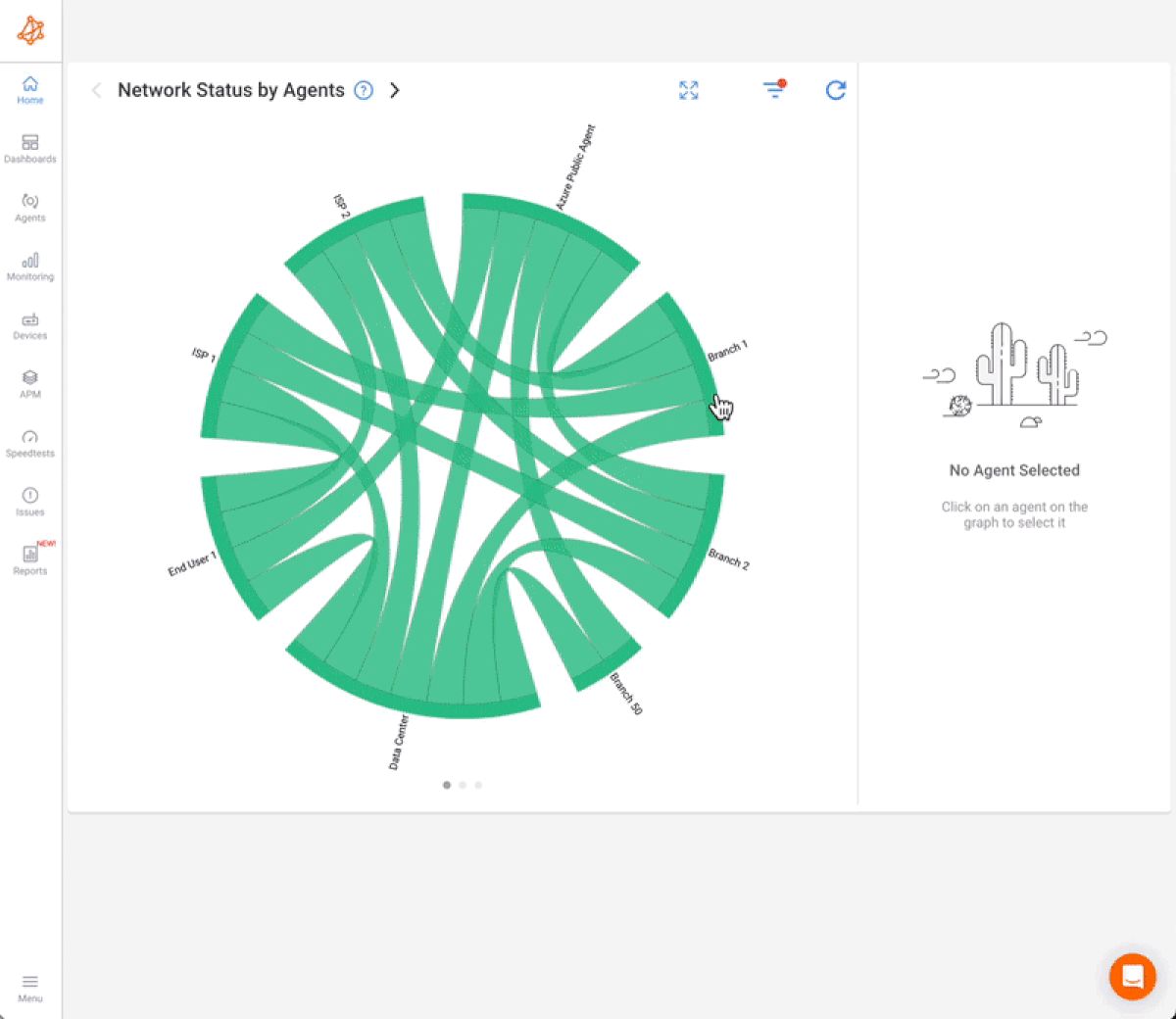
Measuring network reliability is no longer a challenge with Obkio's Network Performance Monitoring (NPM) tool. Gain real-time insights into your network's performance and ensure uninterrupted connectivity for your business operations.
Getting started is quick and easy. Obkio provides step-by-step guidance to configure your monitoring environment.

Step 2. Deploy Monitoring Agents:
Install Obkio Monitoring Agents at strategic locations within your network. These agents continuously exchange synthetic UDP traffic to collect data on network performance from various points within your infrastructure.
- Local Agents: Installed in the targeted location experiencing network issues. There are several Agent types available (all with the same features), and they can be installed on MacOS, Windows, Linux and more.
- Public Monitoring Agent: These are deployed over the Internet and managed by Obkio. They compare performance up to the Internet and quickly identify if network issues are global or specific to the destination. For example, measure network uptime time between your branch office and Google Cloud.
Step 3. Define Key Network Metrics Related to Network Reliability:
Identify the key network metrics and indicators that are most important for assessing network reliability in your specific environment. These may include metrics like latency, packet loss, jitter, and throughput.
We’ve discussed these metrics in more detail earlier in the article.
Step 4. Collect Real-Time Data:
Once you’ve completed your setup, Obkio's monitoring agents continuously collect real-time data on network performance. This data includes information on latency, packet loss, and other key reliability metrics.
Use Obkio's historical data and trend analysis tools to identify patterns in network reliability. This can help you pinpoint recurring issues and make data-driven decisions for improvements.
Then generate reports on network reliability metrics. These reports can be valuable for sharing information with stakeholders, tracking progress, and demonstrating the effectiveness of reliability improvements.

Step 5. View Dashboard and Alerts:
Access the Obkio dashboard to view real-time and historical data on network reliability. The dashboard provides insights into how your network is performing, allowing you to identify issues or anomalies.
Configure alerts in Obkio to notify you when network reliability metrics exceed predefined thresholds. Alerts can be sent via email or other notification channels to ensure you're informed of potential problems promptly.
Step 6. Take Action and Optimize Network Reliability
When Obkio has identified network problems affecting network performance and reliability, it’s time to take action! This may involve troubleshooting network components, upgrading hardware, or adjusting network configurations.
Use Obkio’s Visual Traceroute tool or Network Device Monitoring feature to further drill down and troubleshoot. Discover whether network issues are happening in your local network or your ISP’s network, and resolve them internally or externally.
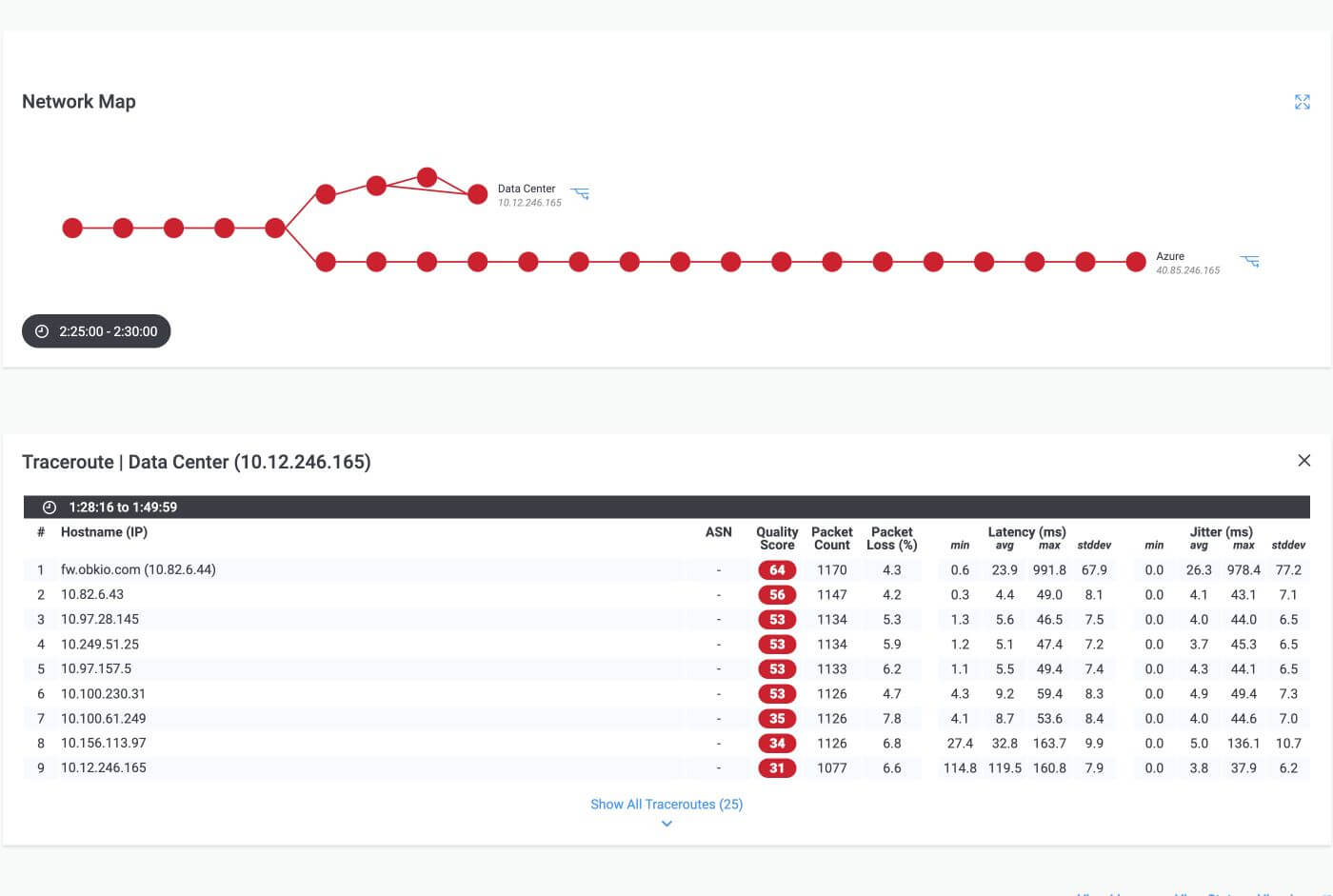
Step 7. Continuously Monitor and Improve Network Reliability & Performance
Network reliability is an ongoing process. Continuously monitor your network using Obkio to ensure that reliability levels meet your business requirements. Make adjustments and improvements as needed.
Network reliability is a critical aspect of network performance, and what's considered "good" or "bad" network reliability can vary depending on the specific needs and expectations of an organization. However, there are some general guidelines and benchmarks that can help assess network reliability:
- High Availability: A reliable network should aim for availability levels of 99.9% or higher (often referred to as "three nines" or "four nines"). This means the network is operational and accessible for the vast majority of the time.
- Low Downtime: Minimal network downtime due to planned maintenance or unexpected failures is a sign of good network reliability. Scheduled downtime should be communicated in advance, and unscheduled downtime should be rare and brief.
- Redundancy: A reliable network often incorporates redundancy in its design. Redundant components, backup links, and failover systems help ensure uninterrupted service even in the face of hardware failures or other issues.
- Quick Recovery: When issues do occur, a reliable network should have a low Mean Time to Repair (MTTR), meaning problems are identified and resolved swiftly to minimize disruptions.
- Consistent Performance: Network reliability is not just about uptime; it also involves delivering consistent performance. Low latency, minimal packet loss, and stable throughput are indicators of good performance within a reliable network.
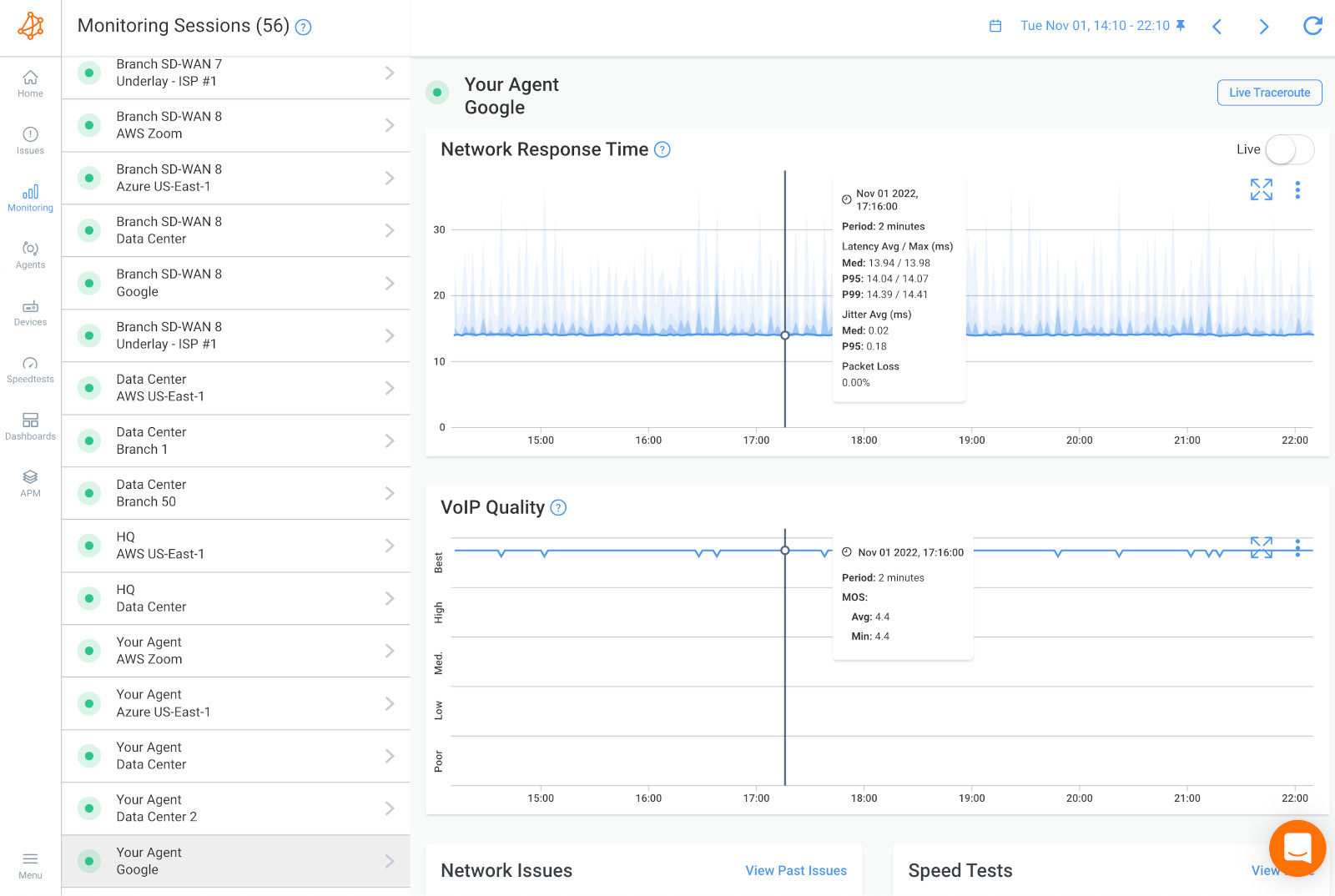
- Frequent Downtime: A network with poor reliability experiences frequent downtime, leading to significant disruptions in operations. Frequent outages can severely impact productivity and customer satisfaction.
- Slow Response to Failures: Inadequate response to network failures, long repair times, and a high MTTR can indicate poor network reliability. These delays can extend downtime.
- Lack of Redundancy: Networks that lack redundancy are more vulnerable to outages. Single points of failure can result in prolonged downtime.
- Unpredictable Performance: Inconsistent network performance, such as erratic latency or high packet loss, can make it challenging to rely on the network for critical tasks.
It's important to note that what constitutes "good" or "bad" network reliability can vary by industry, the criticality of network services to a business, and the level of investment in network infrastructure. Organizations that rely heavily on real-time applications, financial transactions, or healthcare services may require higher levels of reliability than those with less critical operations.
Next, we dive into the critical aspect of ensuring network reliability through systematic testing. Regular network reliability testing is a fundamental practice in network management, and it plays a pivotal role in identifying vulnerabilities, assessing performance, and maintaining a resilient network infrastructure.
Testing isn't just about finding problems; it's about proactively assuring that your network can meet the demands of today's dynamic digital landscape.
Regular testing is a cornerstone of maintaining and enhancing network reliability. Here's why knowing how to test network reliability is so important for businesses.
- Identifying Weaknesses: Regular testing allows you to proactively identify weaknesses, vulnerabilities, or bottlenecks in your network infrastructure. It helps you uncover issues before they lead to widespread failures or downtime.
- Change Management: Networks are dynamic and evolve over time. Regular testing helps assess the impact of changes, upgrades, or new deployments on network reliability. It ensures that modifications don't inadvertently introduce reliability risks.
- Performance Baseline: Testing establishes a performance baseline for your network. It helps you understand what "normal" looks like, making it easier to recognize deviations and potential problems from the network baseline.
- Optimization: Testing provides data that can be used to optimize network configurations, routing, and resource allocation. By understanding how your network behaves under different conditions, you can make informed adjustments.
Network reliability testing encompasses various methods and approaches to assess different aspects of network performance and resilience. Some common types include:
- Performance Testing: Measures network performance metrics such as latency, packet loss, and throughput under various conditions to ensure they meet established standards. This can be done using Obkio’s NPM tool.
- Redundancy Testing: Evaluates the effectiveness of redundant components, links, or failover mechanisms in ensuring uninterrupted service during failures.
- Load Testing: Assesses how the network performs under heavy loads, such as during peak network usage periods. It helps determine if the network can handle increased traffic without degradation.
- Stress Testing: Pushes the network beyond its normal capacity to determine its breaking points. This type of testing reveals vulnerabilities and limitations that may lead to failures under extreme conditions.
- Security Testing: Stress testing focuses on assessing the network's vulnerability to cyberattacks, intrusion attempts, and data breaches. Security testing ensures that network reliability is not compromised by external threats.
- Failover Testing: Specifically tests failover mechanisms to ensure they work as intended when a primary component or link fails. This type of testing verifies that network redundancy is effective.
To ensure that your network reliability testing efforts are effective, consider these best practices:
- Testing Plans: Develop comprehensive testing plans that outline objectives, methodologies, and success criteria for each type of test.
- Testing Frequency: Establish a regular testing schedule to ensure continuous monitoring of network reliability. The frequency may vary based on network criticality.
- Realistic Scenarios: Create test scenarios that closely mimic real-world conditions and usage patterns to provide meaningful results.
- Automation: Consider automating routine tests to ensure consistency and reduce human error. Continuous Network monitoring tools can perform tests at scheduled or continuous intervals.
- Benchmarking: Compare your test results with industry benchmarks or standards to assess how your network reliability measures up.
- Continuous Improvement: Use testing results as a basis for ongoing network improvements. Address identified weaknesses and track progress over time.
Here is an example of a network reliability test, using the Load Testing technique, for a hypothetical network. This test is used to assess network performance under heavy traffic loads and identify any degradation or failures.
Test Metrics:
- Latency: The time it takes for data packets to travel from source to destination.
- Packet Loss: The percentage of data packets that fail to reach their destination.
- Throughput: The amount of data transmitted per unit of time (e.g., Mbps).
Test Results:
1. Latency:
- Average Latency (Normal Load): 15 milliseconds
- Average Latency (Heavy Load): 80 milliseconds
The network's latency significantly increased under heavy load, indicating potential performance degradation during peak usage.
2. Packet Loss:
- Packet Loss Rate (Normal Load): 0.1%
- Packet Loss Rate (Heavy Load): 5%
Packet loss increased substantially under heavy load, which can lead to data retransmissions and reduced application performance.
3. Throughput:
- Throughput (Normal Load): 100 Mbps
- Throughput (Heavy Load): 50 Mbps
The network's throughput decreased by 50% under heavy load, indicating that the network may not be able to handle increased traffic without performance degradation.
Summary and Recommendations:
- The network exhibited increased latency, packet loss, and reduced throughput under heavy load conditions.
- These results suggest that the network may experience performance issues during peak usage.
- Action items include optimizing network configurations, adding additional bandwidth, or implementing Quality of Service (QoS) measures to ensure consistent performance under heavy load.
Learn how to perform network testing using Network Monitoring tools to test network performance, and identify network bugs and issues.
Learn more

Now, let’s get into the juicy stuff; the crucial process of diagnosing network reliability issues. When your network experiences problems, it's essential to identify and resolve them swiftly. This section is all about recognizing common network reliability challenges and following a step-by-step approach to pinpoint their causes.
From congestion and hardware glitches to software hiccups and security concerns, we'll cover the issues that can disrupt your network's dependability. We'll also explore the systematic methods used for efficient troubleshooting and root cause analysis. With these skills at your disposal, you'll be well-prepared to maintain a stable and reliable network infrastructure.
Network reliability issues can arise from various sources, and identifying these common problems is crucial for maintaining a dependable network. Let’s go over them!
- Network Congestion: Heavy traffic can lead to network congestion, causing slowdowns and packet loss. Identifying areas of congestion helps alleviate performance issues.
- Hardware Failures: Defective or aging hardware components, such as routers, switches, or cables, can disrupt network reliability. Monitoring hardware health is essential for proactive maintenance.
- Software Bugs and Glitches: Software issues, including firmware bugs or misconfigurations, can introduce vulnerabilities and instability into the network.
- Security Threats: Cyberattacks, malware, and unauthorized access can compromise network reliability and security. Identifying and mitigating security threats is critical.
- Network Configuration Errors: Misconfigured network settings can lead to connectivity problems, routing issues, and performance bottlenecks.
- DNS Issues: Domain Name System (DNS) problems can disrupt network services, causing delays in name resolution and access to websites.
- Link Failures: Failures in network links or connections, including physical cable issues, can result in downtime or packet loss.
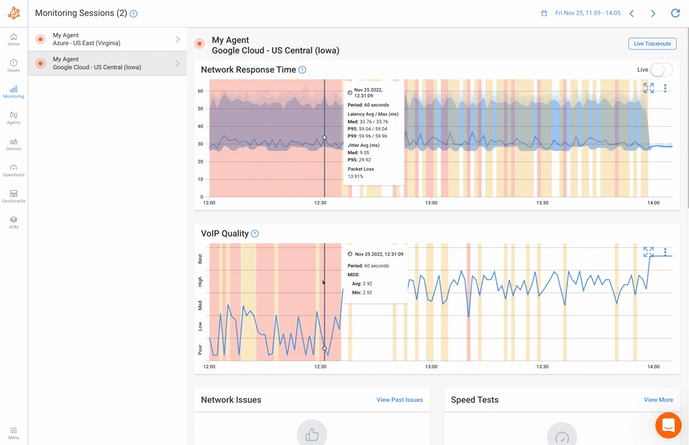

Efficient troubleshooting and root cause analysis are essential when network reliability issues arise:
- Isolation: Begin by isolating the problem. Determine if the issue is localized to a specific segment of the network or if it affects the entire infrastructure. Obkio’s Network Performance Monitoring tool can help you do this by monitoring end-to-end network performance and isolating the issue for you.
- Collect Data: Gather relevant data and logs to understand the scope and nature of the problem. Network monitoring tools, error logs, and performance metrics are valuable sources of information.
- Eliminate Variables: Rule out potential causes by systematically eliminating variables. This process helps narrow down the list of possible root causes.
- Prioritize: Prioritize issues based on their impact on network reliability and critical business services. Address critical issues first to minimize downtime.
- Testing and Validation: Implement test scenarios to validate potential root causes. Testing can help confirm or eliminate specific issues.
- Resolution: Implement solutions to address the root cause of the issue. This may involve hardware replacement, software updates, configuration changes, or security measures.
- Monitoring and Prevention: After resolving the issue, continue monitoring the network to ensure that the problem does not reoccur. Implement preventive measures to mitigate similar issues in the future.
- Continuous Improvement: Use the lessons learned from troubleshooting to improve network reliability over time. Proactively address vulnerabilities and implement network monitoring best practices.
Poor network reliability can stem from various factors and issues within a network infrastructure. Identifying the root causes of poor network reliability is crucial for troubleshooting and improving overall performance.
While your NPM tool or other network troubleshooting tools will help you identify the root causes of poor network reliability, Here are common causes of poor network reliability so you know what to look out for:
- Network Congestion: When network traffic exceeds its capacity, it can lead to WAN or LAN congestion and performance degradation. This often occurs during peak usage times or due to inefficient resource allocation.
- Hardware Failures: Faulty or aging network hardware components, such as routers, switches, or cables, can disrupt network reliability. Hardware failures may result from wear and tear, power surges, or manufacturing defects.
- Software Bugs and Glitches: Software issues, including firmware bugs, misconfigurations, or compatibility problems, can introduce vulnerabilities and instability into the network.
- Security Threats: Cyberattacks, malware, and unauthorized access can compromise network reliability and security. Security breaches can disrupt network operations and lead to data breaches.
- Configuration Errors: Misconfigured network settings, including routing tables, firewall rules, or Quality of Service (QoS) policies, can lead to connectivity problems and performance bottlenecks.
- DNS Issues: Domain Name System (DNS) problems can disrupt network services, causing delays in name resolution and access to websites. DNS misconfigurations or attacks can impact reliability.
- Link Failures: Failures in network links or connections, such as broken cables or fiber cuts, can result in downtime or packet loss. Redundancy and failover mechanisms are used to mitigate link failures
- Power Outages: Power disruptions or outages can cause network equipment to go offline, impacting network reliability. Uninterruptible Power Supplies (UPS) and backup power sources are used to address this issue.
- Resource Limitations: Insufficient bandwidth, processing power, or memory resources can limit network performance and reliability. Scaling network resources is essential as demands grow.
- Network Overload: Overloading network resources with too many simultaneous connections or data transfers can strain the network and degrade reliability.
- Outdated Technology: Using outdated or unsupported network equipment and protocols can expose the network to vulnerabilities and hinder reliability.
- Insufficient Redundancy: Lack of redundancy in critical network components or services can make the network vulnerable to failures.
- Human Error: Mistakes made by network administrators or users, such as accidental configuration changes or security lapses, can lead to reliability issues.
Identifying and addressing these common causes of poor network reliability requires a proactive approach to network management, regular monitoring, timely maintenance, and adherence to best practices in network design and security. By recognizing these issues, organizations can take steps to mitigate their impact and ensure a more stable and dependable network environment.

Next is a deep dive into the world of enhancing network reliability—a mission-critical pursuit in the ever-connected digital landscape. Let’s explore a triad of strategies designed to fortify your network's backbone and increase network reliability.
- Redundant Components: Implementing redundant network components, such as routers, switches, and power supplies, ensures that if one fails, another takes over seamlessly. Redundancy minimizes downtime and enhances network reliability.
- Failover Mechanisms: Configure failover mechanisms for critical network services and links. This ensures that if the primary component or link fails, traffic is rerouted to a backup, maintaining continuous service.
- Load Balancing: Load balancing distributes network traffic evenly across multiple paths or servers. This not only optimizes resource utilization but also enhances reliability by preventing overloading of individual components.
- Geographic Redundancy: For mission-critical applications, consider geographic redundancy. This involves replicating network infrastructure in separate geographic locations to ensure service continuity even in the event of a regional outage.
- Quality of Service (QoS): Implement QoS policies to prioritize critical applications and services over less important traffic. QoS ensures that essential functions receive the necessary network resources and maintain reliability.
- Traffic Shaping: Use traffic shaping to control the flow of data and prevent network congestion and network overload. This technique regulates data rates and prioritizes traffic to maintain consistent performance.
- Content Delivery Networks (CDNs): CDNs cache and distribute content to edge servers located closer to end-users. This reduces latency and improves content delivery reliability.
- Bandwidth Management: Employ bandwidth management tools to allocate bandwidth resources efficiently. This ensures that bandwidth is available where it's needed most.
- Network Monitoring: Continuously monitor network performance and reliability using tools like Obkio's Network Performance Monitoring (NPM) tool. Proactive monitoring helps identify issues before they impact users.
- Hardware Upgrades: Replace outdated or unreliable network hardware with newer, more robust equipment. This includes upgrading routers, network switches, and network cables to improve performance and reduce failure rates.
- Firmware Updates: Regularly update firmware and software on network devices to patch security vulnerabilities, fix bugs, and enhance reliability.
- Backup Power: Invest in backup power solutions, such as Uninterruptible Power Supplies (UPS) and backup generators, to maintain network uptime during power outages.
- Redundant Data Centers: Many cloud service providers operate multiple data centers across different geographic regions. Leveraging these data centers for redundancy ensures that your services remain available even if one data center experiences issues.
- Load Balancing: Cloud providers offer load-balancing services that distribute incoming traffic across multiple servers or instances. This not only improves performance but also enhances reliability by ensuring that traffic is automatically redirected if one server fails.
- Managed Services: Cloud providers offer managed services for various network functions, such as content delivery, database management, and security. These services offload management tasks and ensure high availability and reliability
- Disaster Recovery: Cloud-based disaster recovery solutions provide the ability to replicate data and applications to a separate geographic region. This redundancy is crucial for maintaining business continuity in the face of catastrophic events.
By implementing redundancy and failover mechanisms, and optimizing network performance, organizations can create a more resilient and dependable network environment, ensuring minimal downtime and maximum reliability for their users.
Learn how to identify network issues by looking at common problems, causes, consequences and solutions.
Learn more

In the intricate web of modern networking, two core principles stand as pillars of user satisfaction and operational success: network reliability and network performance. While these concepts may appear distinct, they share an intertwined relationship that lies at the heart of a well-functioning network infrastructure.
In this section, we delve into the dynamic interplay between network reliability and performance. We'll explore how these two critical aspects of networking not only coexist but also complement each other in creating a seamless and productive network experience.
Network reliability refers to the ability of a network to consistently provide connectivity and services without unexpected interruptions or failures.
Network reliability primarily concerns the stability and consistency of network operations. It aims to minimize downtime and ensure that the network remains available and functional. Reliability often involves redundancy, failover mechanisms, and robust infrastructure to prevent and recover from network failures.
Example: A reliable network would ensure that critical applications and services, such as email, customer databases, or video conferencing tools, are accessible 24/7 without disruptions.
Network performance relates to the speed, responsiveness, and efficiency of data transmission and service delivery over a network.
Network performance is all about optimizing the network's speed, bandwidth, and latency to provide the best possible user experience. Performance improvements can involve upgrading hardware, optimizing data routing, and implementing Quality of Service (QoS) measures.
Example: A network with excellent performance ensures that files download quickly, web pages load without delays, and video conferences run smoothly with minimal lag.
Network reliability and performance are interconnected. Network performance contributes to reliability by ensuring that services are delivered efficiently and without unnecessary delays. A fast and responsive network can enhance the perception of reliability.
- Trade-offs: There can be trade-offs between network reliability and performance. For instance, implementing extensive redundancy for high reliability may add complexity and slightly impact performance due to increased data routing. Striking the right balance is key.
- User Experience: Both aspects are essential for a positive user experience. Users expect not only consistent access (reliability) but also a fast and responsive network (performance). A network can be considered reliable if it consistently delivers high performance.
- Continuous Improvement: Businesses often focus on both reliability and performance as part of their network management strategies. Regular monitoring, maintenance, and upgrades are essential to maintain and enhance both aspects over time.
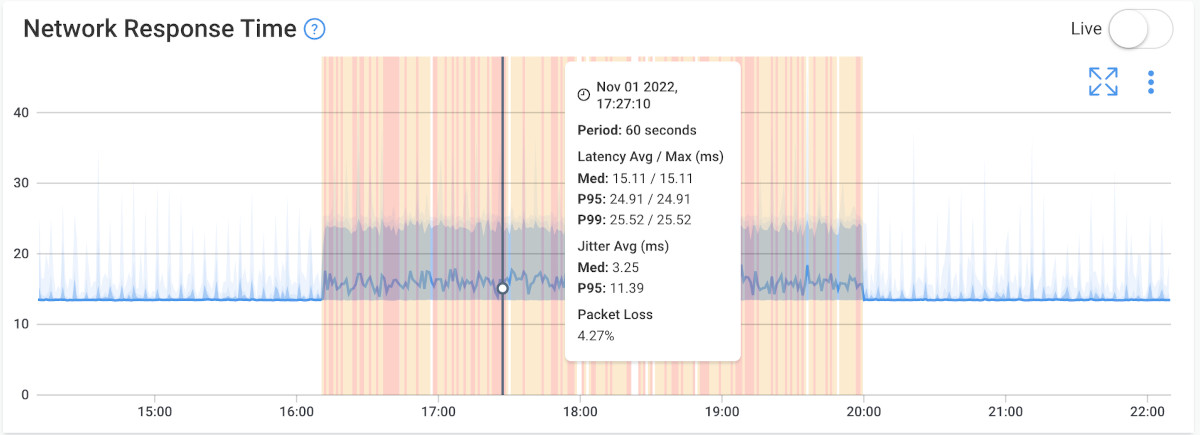
In the fast-paced digital landscape of today, network reliability stands as the linchpin that holds businesses together. It's the foundation upon which seamless communication, uninterrupted productivity, and unparalleled customer experiences are built. As we've journeyed through the chapters of this guide, you've gained valuable insights into the world of network reliability, from its definition to its impact on the bottom line.
Remember that network reliability isn't merely a technological concern; it's a strategic asset that can set your business apart in an interconnected world. Whether you're safeguarding productivity, ensuring smooth customer interactions, or protecting your brand reputation, the reliability of your network infrastructure plays a pivotal role.
But here's the key takeaway: Reliability isn't static. It's an ongoing journey that requires proactive measures, continuous monitoring, and strategic investments in network optimization. That's where Obkio's Network Performance Monitoring (NPM) tool comes into play.

Obkio's NPM tool empowers you with real-time insights, proactive monitoring, and the data-driven decision-making you need to maintain a dependable network infrastructure. Ensure uninterrupted connectivity, protect your business operations, and enhance productivity with Obkio.
Don't leave network reliability to chance. Take control of your network's destiny with Obkio’s Free 14-day Trial!
- 14-day free trial of all premium features
- Deploy in just 10 minutes
- Monitor performance in all key network locations
- Measure real-time network metrics
- Identify and troubleshoot live network problems



























 Obkio Blog
Obkio Blog








